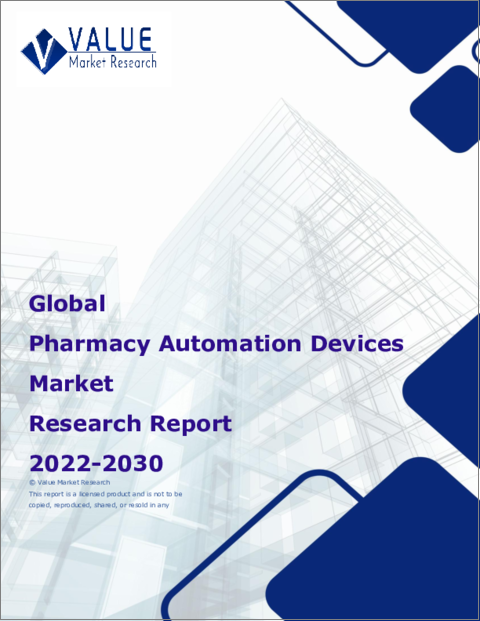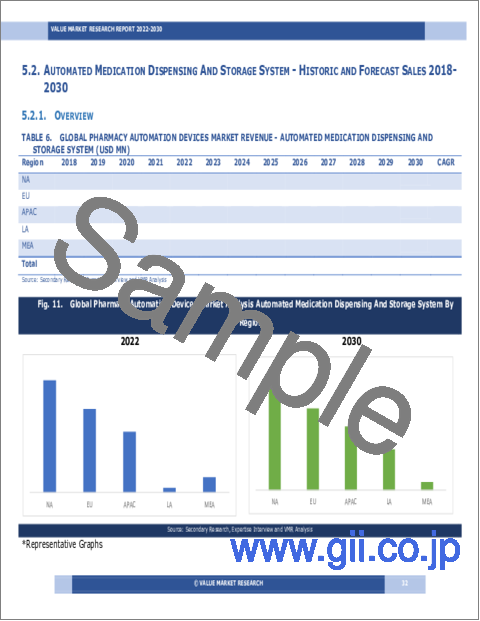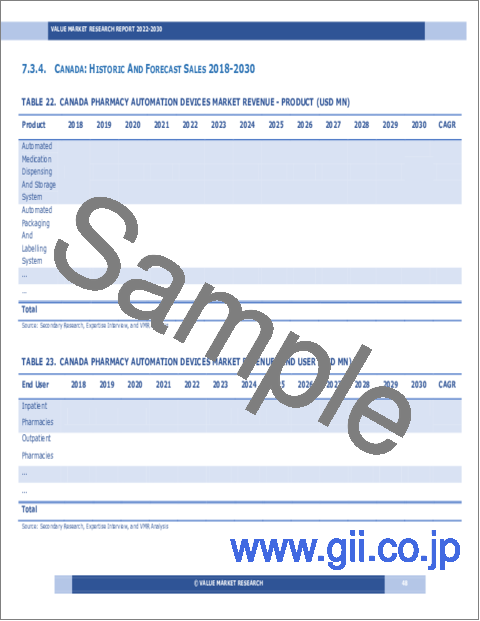|
|
市場調査レポート
商品コード
1305271
ファーマシーオートメーション(薬局自動化)装置の世界市場調査レポート:産業分析、規模、調査シェア、成長、動向、2023~2030年予測Global Pharmacy Automation Devices Market Research Report - Industry Analysis, Size, Share, Growth, Trends and Forecast 2023 to 2030 |
||||||
カスタマイズ可能
|
|||||||
| ファーマシーオートメーション(薬局自動化)装置の世界市場調査レポート:産業分析、規模、調査シェア、成長、動向、2023~2030年予測 |
|
出版日: 2023年06月01日
発行: Value Market Research
ページ情報: 英文 139 Pages
納期: 即日から翌営業日
|
- 全表示
- 概要
- 図表
- 目次
ファーマシーオートメーション(薬局自動化)装置市場の世界需要は、2022年の75億米ドルから2030年には140億米ドル近くの市場規模に達すると推定され、調査期間2022年~2028年のCAGRは8.11%です。
ファーマシーオートメーション(薬局自動化)装置とは、調剤、在庫管理、処方箋充填、包装などの様々な作業やプロセスを自動化するために薬局で使用される様々な技術や機器を指します。これらの機器は、薬局業務の効率性、正確性、安全性を向上させるとともに、ミスを減らし、薬剤師の時間を患者のケアに集中できるように設計されています。ファーマシーオートメーション(薬局自動化)装置の例としては、自動調剤システム、ロボット処方箋ディスペンサー、錠剤計数機、処方箋照合システム、バーコードスキャナー、薬剤包装システムなどがあります。
市場力学:
特に新興諸国では、ヘルスケアサービスに対する需要が高まっているため、処方箋の枚数が増加しています。このため、処方箋記入の効率性と正確性を向上させるファーマシーオートメーション(薬局自動化)装置のニーズが高まっています。エラー削減の必要性。投薬ミスは、入院や死亡など、患者に深刻な結果をもたらす可能性があります。薬局自動化装置は、処方箋の充填と調剤の精度を向上させることで、こうしたエラーのリスクを軽減することができます。効率性、正確性、患者の安全性を高めることを目的とした、ロボット式ディスペンサー、薬剤包装システム、処方検証システムなど、より洗練されたファーマシーオートメーション(薬局自動化)装置の市場開拓も、市場成長の原動力となっています。多くの国の政府は、財政的インセンティブの提供や患者の安全性を向上させるための規制の実施など、ファーマシーオートメーション(薬局自動化)装置の導入を促進するためのイニシアチブを実施しています。薬局自動化装置は、手作業の必要性を減らし、在庫管理を改善することで、薬局のコスト削減に役立ちます。また、最近のCOVID-19パンデミックの発生は、ヘルスケアプロバイダーが感染リスクの低減と業務の効率化を求めているため、薬局自動化装置の需要を高めています。
調査レポートは、ポーターのファイブフォースモデル、市場魅力度分析、バリューチェーン分析をカバーしています。これらのツールは、業界の構造を明確に把握し、世界レベルでの競合の魅力を評価するのに役立ちます。さらに、これらのツールはファーマシーオートメーション(薬局自動化)装置の世界市場における各セグメントを包括的に評価することもできます。ファーマシーオートメーション(薬局自動化)装置産業の成長と動向は、この調査に全体的なアプローチを提供します。
市場セグメンテーション:
ファーマシーオートメーション(薬局自動化)装置市場レポートのこのセクションでは、国および地域レベルのセグメントに関する詳細なデータを提供し、それによって戦略家は、今後の機会で、それぞれの製品やサービスのターゲット層を識別するのに役立ちます。
製品別
- 自動調剤・保管システム
- 自動包装・ラベリングシステム
- 自動卓上カウンター
- 自動調剤システム
- その他薬局自動化システム
エンドユーザー別
- 入院患者薬局
- 外来患者薬局
- 小売薬局
- 薬局給付管理機関および通信販売薬局
地域分析
本セクションでは、北米、欧州、アジア太平洋、ラテンアメリカ、中東アフリカにおけるファーマシーオートメーション(薬局自動化)装置市場の現在と将来の需要を強調する地域展望をカバーします。さらに、すべての主要地域における個々のアプリケーションセグメントの需要、推定・予測にも焦点を当てています。
カスタム要件がある場合は、お問い合わせください。当社の調査チームは、お客様のニーズに応じてカスタマイズしたレポートを提供することができます。
目次
第1章 序文
第2章 エグゼクティブサマリー
- 市場のハイライト
- 世界市場スナップショット
第3章 ファーマシーオートメーション(薬局自動化)装置- 産業分析
- イントロダクション:市場力学
- 市場促進要因
- 市場抑制要因
- 市場機会
- 業界動向
- ポーターのファイブフォース分析
- 市場魅力度分析
第4章 バリューチェーン分析
- バリューチェーン分析
- 原材料分析
- 原材料リスト
- 原材料メーカーリスト
- 主要原材料の価格動向
- 潜在的バイヤーのリスト
- マーケティングチャネル
- ダイレクトマーケティング
- インダイレクトマーケティング
- マーケティングチャネル発展動向
第5章 ファーマシーオートメーション(薬局自動化)装置の世界市場分析:製品別
- 製品別概要
- 実績データと予測データ
- 製品別分析
- 自動調剤・保管システム
- 自動包装・ラベリングシステム
- 自動卓上カウンター
- 自動調剤システム
- その他の薬局自動化システム
第6章 ファーマシーオートメーション(薬局自動化)装置の世界市場分析:エンドユーザー別
- エンドユーザー別概要
- 実績データと予測データ
- エンドユーザー別分析
- 入院患者薬局
- 外来患者薬局
- 小売薬局
- 薬局給付管理機関および通信販売薬局
第7章 ファーマシーオートメーション(薬局自動化)装置の世界市場分析:地域別
- 地域別展望
- イントロダクション
- 北米売上分析
- 概要、実績と予測
- セグメント別
- 国別
- 米国
- カナダ
- メキシコ
- 欧州売上分析
- 概要、実績と予測
- セグメント別
- 国別
- 英国
- フランス
- ドイツ
- イタリア
- ロシア
- その他欧州
- アジア太平洋地域売上分析
- 概要、実績と予測
- セグメント別
- 国別
- 中国
- インド
- 日本
- 韓国
- オーストラリア
- その他アジア太平洋地域
- ラテンアメリカ売上分析
- 概要、実績と予測
- セグメント別
- 国別
- ブラジル
- アルゼンチン
- ペルー
- チリ
- その他ラテンアメリカ
- 中東・アフリカ売上分析
- 概要、実績と予測
- セグメント別
- 国別
- サウジアラビア
- アラブ首長国連邦
- イスラエル
- 南アフリカ
- その他中東とアフリカ
第8章 ファーマシーオートメーション(薬局自動化)装置企業の競合情勢
- ファーマシーオートメーション(薬局自動化)装置市場の競合
- 提携・協力・合意
- 合併・買収
- 新製品の発売
- その他の開発
第9章 企業プロファイル
- 上位企業の市場シェア分析
- 市場集中度
- Becton
- Dickinson And Company
- Omnicell Inc
- KUKA AG
- Baxter International Inc
- Capsa Healthcare
- cerner Corporation
- Yuyama Co Ltd
- ARxIUM Inc
- Parata System LLC
- Rxsafe LLC
- ScriptPro LLC
注-企業プロファイルにおいて、財務の詳細や最近の動向は、非公開会社の場合、入手可能であるか、またはカバーしていない場合があります。
LIST OF TABLES
- Market Snapshot
- Drivers : Impact Analysis
- Restraints : Impact Analysis
- List of Raw Material
- List of Raw Material Manufactures
- List of Potential Buyers
- Analysis by Product (USD MN)
- Automated Medication Dispensing And Storage System Market Sales by Geography (USD MN)
- Automated Packaging And Labelling System Market Sales by Geography (USD MN)
- Automated Tabletop Counters Market Sales by Geography (USD MN)
- Automated Medication Compounding System Market Sales by Geography (USD MN)
- Other Pharmacy Automation System Market Sales by Geography (USD MN)
- Analysis Market by End User (USD MN)
- Inpatient Pharmacies Market Sales by Geography (USD MN)
- Outpatient Pharmacies Market Sales by Geography (USD MN)
- Retail Pharmacies Market Sales by Geography (USD MN)
- Pharmacy Benefit Management Organization And Mail-Order Pharmacies Market Sales by Geography (USD MN)
- Global Pharmacy Automation Devices Market Sales by Geography (USD MN)
- North America Market Analysis (USD MN)
- United State Market Analysis (USD MN)
- Canada Market Analysis (USD MN)
- Mexico Market Analysis (USD MN)
- Europe Market Analysis (USD MN)
- Europe Market Estimate by Country (USD MN)
- United Kingdom Market Analysis (USD MN)
- France Market Analysis (USD MN)
- Germany Market Analysis (USD MN)
- Italy Market Analysis (USD MN)
- Russia Market Analysis (USD MN)
- Spain Market Analysis (USD MN)
- Rest of Europe Market Analysis (USD MN)
- Asia Pacific Market Analysis (USD MN)
- China Market Analysis (USD MN)
- Japan Market Analysis (USD MN)
- India Market Analysis (USD MN)
- South Korea Market Analysis (USD MN)
- Australia Market Analysis (USD MN)
- Rest of Asia Pacific Market Analysis (USD MN)
- Latin America Market Analysis (USD MN)
- Brazil Market Analysis (USD MN)
- Argentina Market Analysis (USD MN)
- Peru Market Analysis (USD MN)
- Chile Market Analysis (USD MN)
- Rest of Latin America Market Analysis (USD MN)
- Middle East & Africa Market Analysis (USD MN)
- Saudi Arabia Market Analysis (USD MN)
- UAE Market Analysis (USD MN)
- Israel Market Analysis (USD MN)
- South Africa Market Analysis (USD MN)
- Rest of Middle East and Africa Market Analysis (USD MN)
- Partnership/Collaboration/Agreement
- Mergers And Acquisition
LIST OF FIGURES
- Research Scope of Pharmacy Automation Devices Report
- Market Research Process
- Market Research Methodology
- Global Pharmacy Automation Devices Market Size, by Region (USD MN)
- Porters Five Forces Analysis
- Market Attractiveness Analysis by Product
- Market Attractiveness Analysis by End User
- Market Attractiveness Analysis by Region
- Value Chain Analysis
- Global Market Analysis by Product (USD MN)
- Automated Medication Dispensing And Storage System Market Sales by Geography (USD MN)
- Automated Packaging And Labelling System Market Sales by Geography (USD MN)
- Automated Tabletop Counters Market Sales by Geography (USD MN)
- Automated Medication Compounding System Market Sales by Geography (USD MN)
- Other Pharmacy Automation System Market Sales by Geography (USD MN)
- Global Market Analysis by End User (USD MN)
- Inpatient Pharmacies Market Sales by Geography (USD MN)
- Outpatient Pharmacies Market Sales by Geography (USD MN)
- Retail Pharmacies Market Sales by Geography (USD MN)
- Pharmacy Benefit Management Organization And Mail-Order Pharmacies Market Sales by Geography (USD MN)
- Global Market Sales (USD MN)
- North America Market Sales (USD MN)
- Europe Market Sales (USD MN)
- Asia Pacific Market Sales (USD MN)
- Latin America Market Sales (USD MN)
- Middle East & Africa Market Sales (USD MN)
- Recent Development in Industry
- Top Companies Market Share Analysis
Kindly note that the above listed are the basic tables and figures of the report and are not limited to the TOC.
The global demand for Pharmacy Automation Devices Market is presumed to reach the market size of nearly USD 14 BN by 2030 from USD 7.5 BN in 2022 with a CAGR of 8.11% under the study period 2022 - 2028.
Pharmacy automation devices refer to a range of technologies and equipment used in pharmacies to automate various tasks and processes, such as dispensing medication, inventory management, prescription filling, and packaging. These devices are designed to improve efficiency, accuracy, and safety in pharmacy operations while reducing errors and freeing up pharmacists' time to focus on patient care. Some examples of pharmacy automation devices include automated dispensing systems, robotic prescription dispensers, pill counting machines, prescription verification systems, barcode scanners, and medication packaging systems.
Market Dynamics:
The growing demand for healthcare services, especially in developing countries, has led to an increase in the number of prescriptions being filled. This has created a need for pharmacy automation devices to improve efficiency and accuracy in filling these prescriptions. Need for error reduction. Medication errors can have serious consequences for patients, including hospitalization and death. Pharmacy automation devices can reduce the risk of these errors by improving accuracy in prescription filling and dispensing. The development of more sophisticated pharmacy automation devices, including robotic dispensers, medication packaging systems, and prescription verification systems which aim to increase efficiency, accuracy, and patient safety, is also driving the market growth. Governments in many countries are implementing initiatives to promote the adoption of pharmacy automation devices, such as offering financial incentives and implementing regulations to improve patient safety. Pharmacy automation devices can help pharmacies save costs by reducing the need for manual labor and improving inventory management. The outbreak of the recent COVID-19 pandemic has also increased the demand for pharmacy automation devices as healthcare providers seek to reduce the risk of infection and improve efficiency in their operations.
The research report covers Porter's Five Forces Model, Market Attractiveness Analysis, and Value Chain analysis. These tools help to get a clear picture of the industry's structure and evaluate the competition attractiveness at a global level. Additionally, these tools also give an inclusive assessment of each segment in the global market of pharmacy automation devices. The growth and trends of pharmacy automation devices industry provide a holistic approach to this study.
Market Segmentation:
This section of the pharmacy automation devices market report provides detailed data on the segments at country and regional level, thereby assisting the strategist in identifying the target demographics for the respective product or services with the upcoming opportunities.
By Product
- Automated Medication Dispensing And Storage System
- Automated Packaging And Labelling System
- Automated Tabletop Counters
- Automated Medication Compounding System
- Other Pharmacy Automation System
By End User
- Inpatient Pharmacies
- Outpatient Pharmacies
- Retail Pharmacies
- Pharmacy Benefit Management Organization And Mail-Order Pharmacies
Regional Analysis
This section covers the regional outlook, which accentuates current and future demand for the Pharmacy Automation Devices market across North America, Europe, Asia-Pacific, Latin America, and Middle East & Africa. Further, the report focuses on demand, estimation, and forecast for individual application segments across all the prominent regions.
The research report also covers the comprehensive profiles of the key players in the market and an in-depth view of the competitive landscape worldwide. The major players in the pharmacy automation devices market include Becton, Dickinson and Company, Omnicell Inc, KUKA AG, Baxter International Inc, Capsa Healthcare, cerner Corporation, Yuyama Co Ltd, ARxIUM Inc, Parata System LLC, Rxsafe LLC, ScriptPro LLC. This section consists of a holistic view of the competitive landscape that includes various strategic developments such as key mergers & acquisitions, future capacities, partnerships, financial overviews, collaborations, new product developments, new product launches, and other developments.
In case you have any custom requirements, do write to us. Our research team can offer a customized report as per your need.
TABLE OF CONTENTS
1 . PREFACE
- 1.1. Report Description
- 1.1.1. Objective
- 1.1.2. Target Audience
- 1.1.3. Unique Selling Proposition (USP) & offerings
- 1.2. Research Scope
- 1.3. Research Methodology
- 1.3.1. Market Research Process
- 1.3.2. Market Research Methodology
2 . EXECUTIVE SUMMARY
- 2.1. Highlights of Market
- 2.2. Global Market Snapshot
3 . PHARMACY AUTOMATION DEVICES - INDUSTRY ANALYSIS
- 3.1. Introduction - Market Dynamics
- 3.2. Market Drivers
- 3.3. Market Restraints
- 3.4. Opportunities
- 3.5. Industry Trends
- 3.6. Porter's Five Force Analysis
- 3.7. Market Attractiveness Analysis
- 3.7.1 Market Attractiveness Analysis By Product
- 3.7.2 Market Attractiveness Analysis By End User
- 3.7.3 Market Attractiveness Analysis By Region
4 . VALUE CHAIN ANALYSIS
- 4.1. Value Chain Analysis
- 4.2. Raw Material Analysis
- 4.2.1. List of Raw Materials
- 4.2.2. Raw Material Manufactures List
- 4.2.3. Price Trend of Key Raw Materials
- 4.3. List of Potential Buyers
- 4.4. Marketing Channel
- 4.4.1. Direct Marketing
- 4.4.2. Indirect Marketing
- 4.4.3. Marketing Channel Development Trend
5 . GLOBAL PHARMACY AUTOMATION DEVICES MARKET ANALYSIS BY PRODUCT
- 5.1 Overview by Product
- 5.2 Historical and Forecast Data
- 5.3 Analysis by Product
- 5.4 Automated Medication Dispensing And Storage System Historic and Forecast Sales by Regions
- 5.5 Automated Packaging And Labelling System Historic and Forecast Sales by Regions
- 5.6 Automated Tabletop Counters Historic and Forecast Sales by Regions
- 5.7 Automated Medication Compounding System Historic and Forecast Sales by Regions
- 5.8 Other Pharmacy Automation System Historic and Forecast Sales by Regions
6 . GLOBAL PHARMACY AUTOMATION DEVICES MARKET ANALYSIS BY END USER
- 6.1 Overview by End User
- 6.2 Historical and Forecast Data
- 6.3 Analysis by End User
- 6.4 Inpatient Pharmacies Historic and Forecast Sales by Regions
- 6.5 Outpatient Pharmacies Historic and Forecast Sales by Regions
- 6.6 Retail Pharmacies Historic and Forecast Sales by Regions
- 6.7 Pharmacy Benefit Management Organization And Mail-Order Pharmacies Historic and Forecast Sales by Regions
7 . GLOBAL PHARMACY AUTOMATION DEVICES MARKET ANALYSIS BY GEOGRAPHY
- 7.1. Regional Outlook
- 7.2. Introduction
- 7.3. North America Sales Analysis
- 7.3.1. Overview, Historic and Forecast Data Sales Analysis
- 7.3.2. North America By Segment Sales Analysis
- 7.3.3. North America By Country Sales Analysis
- 7.3.4. United State Sales Analysis
- 7.3.5. Canada Sales Analysis
- 7.3.6. Mexico Sales Analysis
- 7.4. Europe Sales Analysis
- 7.4.1. Overview, Historic and Forecast Data Sales Analysis
- 7.4.2. Europe by Segment Sales Analysis
- 7.4.3. Europe by Country Sales Analysis
- 7.4.4. United Kingdom Sales Analysis
- 7.4.5. France Sales Analysis
- 7.4.6. Germany Sales Analysis
- 7.4.7. Italy Sales Analysis
- 7.4.8. Russia Sales Analysis
- 7.4.9. Rest Of Europe Sales Analysis
- 7.5. Asia Pacific Sales Analysis
- 7.5.1. Overview, Historic and Forecast Data Sales Analysis
- 7.5.2. Asia Pacific by Segment Sales Analysis
- 7.5.3. Asia Pacific by Country Sales Analysis
- 7.5.4. China Sales Analysis
- 7.5.5. India Sales Analysis
- 7.5.6. Japan Sales Analysis
- 7.5.7. South Korea Sales Analysis
- 7.5.8. Australia Sales Analysis
- 7.5.9. Rest Of Asia Pacific Sales Analysis
- 7.6. Latin America Sales Analysis
- 7.6.1. Overview, Historic and Forecast Data Sales Analysis
- 7.6.2. Latin America by Segment Sales Analysis
- 7.6.3. Latin America by Country Sales Analysis
- 7.6.4. Brazil Sales Analysis
- 7.6.5. Argentina Sales Analysis
- 7.6.6. Peru Sales Analysis
- 7.6.7. Chile Sales Analysis
- 7.6.8. Rest of Latin America Sales Analysis
- 7.7. Middle East & Africa Sales Analysis
- 7.7.1. Overview, Historic and Forecast Data Sales Analysis
- 7.7.2. Middle East & Africa by Segment Sales Analysis
- 7.7.3. Middle East & Africa by Country Sales Analysis
- 7.7.4. Saudi Arabia Sales Analysis
- 7.7.5. UAE Sales Analysis
- 7.7.6. Israel Sales Analysis
- 7.7.7. South Africa Sales Analysis
- 7.7.8. Rest Of Middle East And Africa Sales Analysis
8 . COMPETITIVE LANDSCAPE OF THE PHARMACY AUTOMATION DEVICES COMPANIES
- 8.1. Pharmacy Automation Devices Market Competition
- 8.2. Partnership/Collaboration/Agreement
- 8.3. Merger And Acquisitions
- 8.4. New Product Launch
- 8.5. Other Developments
9 . COMPANY PROFILES OF PHARMACY AUTOMATION DEVICES INDUSTRY
- 9.1. Top Companies Market Share Analysis
- 9.2. Market Concentration Rate
- 9.3. Becton
- 9.3.1. Company Overview
- 9.3.2. Company Revenue
- 9.3.3. Products
- 9.3.4. Recent Developments
- 9.4. Dickinson And Company
- 9.4.1. Company Overview
- 9.4.2. Company Revenue
- 9.4.3. Products
- 9.4.4. Recent Developments
- 9.5. Omnicell Inc
- 9.5.1. Company Overview
- 9.5.2. Company Revenue
- 9.5.3. Products
- 9.5.4. Recent Developments
- 9.6. KUKA AG
- 9.6.1. Company Overview
- 9.6.2. Company Revenue
- 9.6.3. Products
- 9.6.4. Recent Developments
- 9.7. Baxter International Inc
- 9.7.1. Company Overview
- 9.7.2. Company Revenue
- 9.7.3. Products
- 9.7.4. Recent Developments
- 9.8. Capsa Healthcare
- 9.8.1. Company Overview
- 9.8.2. Company Revenue
- 9.8.3. Products
- 9.8.4. Recent Developments
- 9.9. cerner Corporation
- 9.9.1. Company Overview
- 9.9.2. Company Revenue
- 9.9.3. Products
- 9.9.4. Recent Developments
- 9.10. Yuyama Co Ltd
- 9.10.1. Company Overview
- 9.10.2. Company Revenue
- 9.10.3. Products
- 9.10.4. Recent Developments
- 9.11. ARxIUM Inc
- 9.11.1. Company Overview
- 9.11.2. Company Revenue
- 9.11.3. Products
- 9.11.4. Recent Developments
- 9.12. Parata System LLC
- 9.12.1. Company Overview
- 9.12.2. Company Revenue
- 9.12.3. Products
- 9.12.4. Recent Developments
- 9.13. Rxsafe LLC
- 9.13.1. Company Overview
- 9.13.2. Company Revenue
- 9.13.3. Products
- 9.13.4. Recent Developments
- 9.14. ScriptPro LLC
- 9.14.1. Company Overview
- 9.14.2. Company Revenue
- 9.14.3. Products
- 9.14.4. Recent Developments
Note - in company profiling, financial details and recent development are subject to availability or might not be covered in case of private companies





